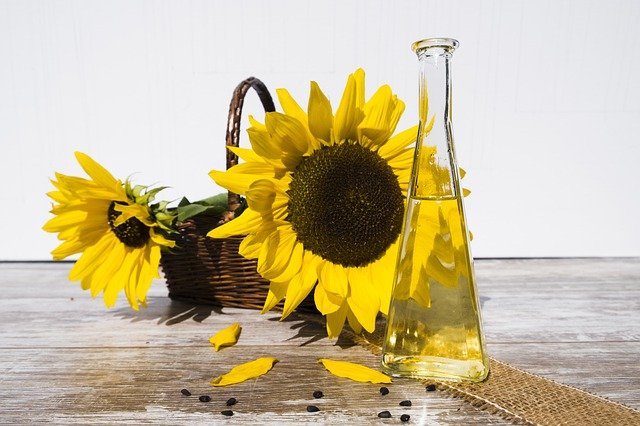Sunflowers, in all their vibrant brilliance, are a happy view to behold – but there’s more to their nature than just exquisiteness. The versatile plant delivers healthy snacks, useful oil, and much more.
So, you can eat a Sunflower? This might sound strange but here’s the truth – sunflower’s is an edible plant. Right from its seeds to oil to microgreens, everything can be consumed by the human race. They are full of nutrients and are now easily available in the market as well.
The Family Origin
Humans have been consuming the sunflower family as their diet for a very long time. Ornamental varieties are just as popular.

Sunflower belongs to the daisy family, and the scientific name is Helianthus Annuus. If you notice closely, you will see that it is actually made up of many tiny flowers clustered together. One of the most interesting facts about the sunflower family is that they do not store energy as starch. Instead, they accumulate it in a form of plant sugar (fructan) called inulin.
Sunflower Habitat
The sunflower plant is native to North and South America. They were exported to the rest of the world by Spanish travellers around 1500s and is now harvested around the world. Tsar Peter the Great became so fascinated by the sunny flowers of Netherlands that he had to take them back to Russia with him. Did you know the sunflower cultivation is thought to have begun over 8,000 years ago? Some even suggest sunflower farming began before corn and beans!

About 3 to 15 feet high is the common sunflower, which blooms annually. The stem is hairy, have coarse teeth, and rough leaves that are arranged spirally. The flower head is about 7.5-15 cm in width, these flowers can be found in Andhra Pradesh, Maharashtra, Bihar, Odisha, Tamil Nadu & Karnataka states of India
There are more than 60 types of sunflowers. The flowers are brown, yellow, or purple in colour. The yellow ones are most common. A healthy sunflower plant prefers at least six hours of direct sunlight daily and adult sunflowers can withstand intense heat because they are drought-tolerant. Sunflowers bloom best in well-dug soil that is loose and had enough drainage capacity for its long taproots to stretch. These gorgeous flowers are heavy feeders, thus the soil needs to be enriched with organic or compost manure.
Sunflowers track the Sun
Sunflowers display a behaviour called heliotropism, it means they prefer to face the sun from east to west. But as the flower ages and seeds start to grow in them, the plant becomes heavier and stiffer for any kind of movement so it remains facing east.

Self-Pollination
Sunflowers attract bees, making them useful for beekeeping. The plant is capable of self-pollination and reproduce. The product of self-pollination is identical to the parent plant.

Significance of Sunflower in Other Cultures
A depiction of positivity-evoking ornate plant, sunflowers are in trend to be used in art, fashion and for home decor as they inspire a great amount of creativity. They are a natural decontaminator and can remove toxins, such as lead, arsenic, and uranium from soils and have been used to clean some of the world’s biggest environmental disasters, including Chernobyl and Fukushima. The state flower of Kansas and the national flower of Ukraine, sunflower is largely used to decorate homes and offices in India during festivities.
Economic Source: Leaves, Flower, Oil, Seeds

Sunflowers are extremely valued economically as well as from an ornamental point of view. The leaves are used as fodder, the flowers yield a yellow dye, and the seeds contain oil that’s considered equally healthy compared to olive or almond oil for cooking purposes. Sunflower oil cake is often used for stock and poultry feeding in birdseed mixes. Moreover, it is useful in soaps and paints for lubrication.
Tips for Eating Seeds
Sunflower plants’ larger flower heads are the source of seed harvesting. A single flower may contain up to 2,000 seeds.

The seeds are popularly used in multi-grain bread, in nutrition bars and for snacking straight from the bag, just like nuts. These seeds are roasted to enhance their mild nutty flavour, the texture is firm and tender.

To consume, you can directly sprinkle them on baked goods, on a green salad, diced fruit, fries, yoghurt, sautéed vegetables, fish or chicken salad and even sprouts! Sunflower seed butter is also widely used. Today, these seeds have become a common addition to sandwiches, soups, salads, scrambled eggs, and wraps for health and taste enhancers.

Nutritional Value of Sunflower Seeds

Sunflower seeds have antioxidants which protect your body’s cells, help lower blood pressure, cholesterol and blood sugar.
Its seeds are prone to becoming sour due to their high-fat content. Hence, it’s best to store them in an airtight container and refrigerate.
Sunflower Microgreens
Microgreens are the shoots of plants picked just after the first leaves have developed. In sunflower’s case, these are done from the sprouted seeds of the plant. They contain up to 100 times more regular enzymes than their fully-grown counterparts.

Sunflower microgreens are rich in fibre, protein, essential fatty acids and vitamins. They are a great source of vegetable protein, help build blood and revitalize tissues.
As far as the Cauldron Sisters are concerned, we put sunflower microgreens in almost everything. Recently, we garnished our Maggi with it and how!

What’s your story of Sunflower – its seeds, oil, microgreens, etc.? Tell us in the comment section!


